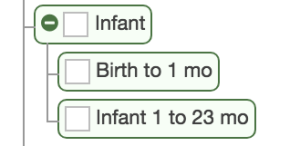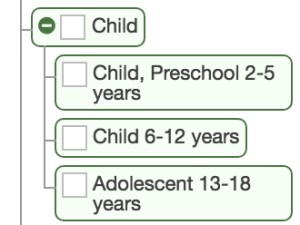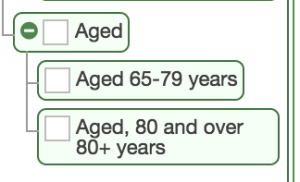| Excerpt |
|---|
The P in PICO describes the main characteristics of the participants in a study (sex, age range and condition). When annotating the Population or Participants it is important to consider the question that is the focus of the review. This is the population group that the intervention will directly affect. |
| Table of Contents | ||
|---|---|---|
|
Healthy Population
Term | Vocabulary URI | Notes |
|---|---|---|
Healthy | Use this term if the authors have stated 'Healthy People' i.e. those who are being assessed for prevention of or at risk of diseases |
Condition/Population is not specified
If the population or group is not specified this field should be left empty.
Examples:
| CD number | Review title | Population as stated in the in the inclusion criteria |
|---|---|---|
| CD012805 | Aluminium adjuvants used in vaccines versus placebo or no intervention | We will include all trial participants regardless of sex, age, ethnicity, diagnosis, comorbidity, and country of residence. |
| CD011047 | We included trials in adults (aged 18 years and over) with any condition or disease. | |
| CD008077 | Slow versus fast subcutaneous heparin injections for prevention of bruising and site pain intensity | We included studies in which participants were males and females 18 years of age or older who were admitted to hospitals or clinics and treated with subcutaneous injections of heparin including LMWH and UFH. |
Prevention and Risk
Some reviews look at the prevention of or at risk of a condition. In this case the condition field is left blank will likely be annotated as an outcome.
| Expand | |||||||||
|---|---|---|---|---|---|---|---|---|---|
| |||||||||
|
Two different populations
- The Population of a review or study sometimes contains two different populations (e.g. parent and child, patient and provider, student and teacher, etc.)
- The P section in our annotations is set up with the assumption that each P would reflect a single homogeneous group of individuals
- If P is not clear check the interventions, comparisons or outcomes to determine who is the target of the intervention, or will have outcome measurements performed
| Expand | ||||||||||||||||||||||||||||
|---|---|---|---|---|---|---|---|---|---|---|---|---|---|---|---|---|---|---|---|---|---|---|---|---|---|---|---|---|
| ||||||||||||||||||||||||||||
|
Sex (gender)
- Annotate the specific sex stated in the review
- If none is is stated select male and female except where it may be obvious that the sex is one or the other, e.g. Pregnancy.
Age
- The age groupings have been taken from MeSH
- Some groupings may not reflect precisely the specific age group stated in the review e.g. authors may state adults from 20 to 35 years of age for which the annotator would need to select Adult 19-44
- Adolescent is listed under 'Child'. Under Adult we have Young Adult Years (19-24) and Adult (19-44)
- A number of studies will state in their inclusion criteria Aged 18 years or older. Please annotate as Adult & Aged (or select the specific group(s) within each category) as required.
| Expand | |||||||||||
|---|---|---|---|---|---|---|---|---|---|---|---|
| |||||||||||
|
| HTML |
|---|
<script type="text/javascript">
AJS.toInit(function(){
AJS.$('#comments-section').hide();
});
for (var i=0; i<nr_li; i++) {
// if the element has the class fom 'clasa' parameter
if(tags_li[i].getAttribute('class') == 'innerCell'){
tags_li[i].style.overflow = 'visible';
//tags_li[i].style.overflow-y= 'visible';
}
}
</script> |



